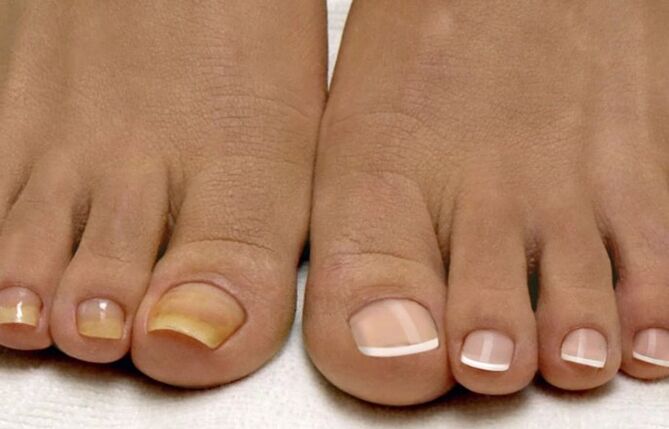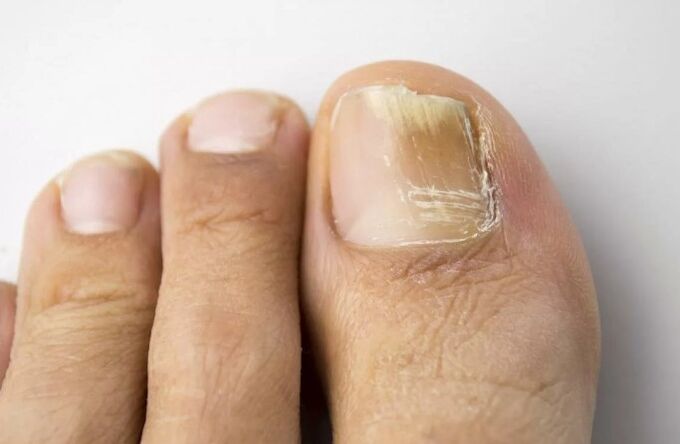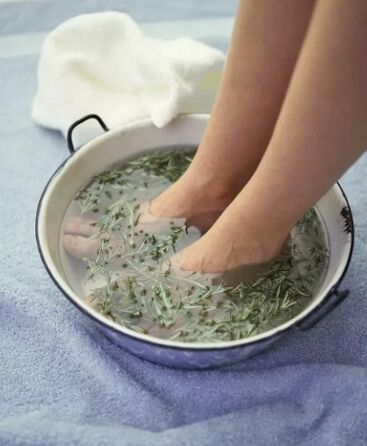The fungus of the nails and skin of the feet is a very popular phenomenon in modern society. Its main negative characteristic is the fact that this disease is subject to frequent relapses. Medicines against this subspecies of fungal diseases are quite common in the pharmaceutical market, but the responsible approach to recovery is one of the main factors in the fight against the disease. We will warn that treatment is almost identical to the treatment of the fungus of the hands. Symptoms of nail fungus
Symptoms of nail fungus
Despite the fact that this type of fungal disease is most often called the nail fungus, it should be borne in mind that not only nails but also surrounding skin suffer from harmful fungal spores. So, the main characteristics of the sponge of the legs are:Redness in the interdigital zone, the gradual appearance of peeling;The appearance of itching, at first barely noticeable, but which becomes more severe, since the disease is progressive;Sometimes bubbles with fluid appear on the skin;In the short stages - the appearance of painful cracks;Nail deformation. It may be of a different character depending on the type of fungi. So distinguish:Hypertrophic type deformity. Increasing the thickness of the nail, but at the same time increasing the fragility of the plate. With physical exposure, the nail hurts and breaks down. Normal -profile type of deformation. The thickness of the nail does not change, but it acquires a pronounced shiny color, and horizontal yellow stripes also appear.Atrophic type deformation. The nails become thin and boring. Paints and stripes of white hue appear on the nail, in the future they grow and merge.Diagnosis of mycosis of the feet at home
If you suspect the onset of symptoms of leg fungus, it is best to contact a specialist immediately, as only the doctor will be able to properly determine the affiliation of a fungal disease and prescribe the most effective treatment. However, if you do not have time to go to the hospital, you can confirm or disprove the fears at home. To do this, it is necessary to dilute potassium permanganate (potassium permanganate) until the acquisition of a light purple shade in the water of the water temperature. Then lower your toes into the solution and hold for a few minutes. You will see that a healthy nail will turn a slightly brownish color. While the fungus affected by the fungus will remain the same color.  Preparing for treatment
Preparing for treatment
This element occupies an important place in the whole treatment of the fungus of the skin and the toenails. The following personal hygiene rules are required before each treatment session:Eliminating the affected part of nails with manicure scissors or disposable saws. The procedure should be repeated daily until recovery. Immediately after the procedure, carefully disinfect the tools used.Daily leg disinfectants with soda or soap also contribute to the disappearance of bacteria and accelerated treatment. If you are using local therapy medicines, then it is best to do such baths shortly before administering the medicine.A good additional tool for preparing the nail for treatment is tea tree oil. It is recommended that you apply one drop of oil under your nails and lubricate the surface with another.Compliance with the general rules of hygiene and preventative measures to prevent the fungus of the toenails.Treatment of nail fungus
There are many medicines designed to treat the fungus of the legs.The main category includes local medicines: antifungal lacquers, ointments and creams. Usually medicines are used that are sold without a prescription, treatment usually takes from one to three weeks. It should be borne in mind that treatment with local spectrum drugs should be strictly according to the instructions, otherwise the effect of use may decrease.The second place in popularity is occupied by systemic medicines or in other words, various capsules and tablets. Treatment of the foot fungus with this category of drugs is usually performed after consulting a doctor, as in some cases there are contraindications for their use. In addition, systemic drugs are often supplemented by treatment with topical therapy medicines.  The treatment of mycosis of the legs is also carried out today with a laser. This procedure is gaining popularity only in our country, but it has a number of certain advantages, including: the minimum risk of relapse, mild and painless treatment.A little less popular method for getting rid of fungi of the fingers is the hardware pedicure. However, most often this method of treatment is carried out in combination with systemic medicines. It is more commonly used for advanced stages of the disease.Finally, the last way to get rid of the nail sponge is to surgery. Today, this is a small method of treatment as the procedure is quite painful and has a long rehabilitation period.Treatment of fungi on the feet with folk remedies
The treatment of mycosis of the legs is also carried out today with a laser. This procedure is gaining popularity only in our country, but it has a number of certain advantages, including: the minimum risk of relapse, mild and painless treatment.A little less popular method for getting rid of fungi of the fingers is the hardware pedicure. However, most often this method of treatment is carried out in combination with systemic medicines. It is more commonly used for advanced stages of the disease.Finally, the last way to get rid of the nail sponge is to surgery. Today, this is a small method of treatment as the procedure is quite painful and has a long rehabilitation period.Treatment of fungi on the feet with folk remedies
Treatment with folk methods also handles the treatment of fungi on the legs. Most often, doctors recommend combining folk remedies with proven pharmaceutical drugs. The most popular folk recipes include the following:Treatment with propolis. In a 20% alcoholic solution of propolis, dip a cotton swab and apply a tile on an infected nail for 15 minutes, the treatment lasts for three weeks. Side effect itching from the decision when applying an application.Garlic treatment. Mix two pre -made cloves with a hundred grams of butter and leave the resulting slurry for 24 hours. Then apply the mixture to the areas of the legs affected by the fungus of the skin for a month.Treatment of oak bark. The treatment of fungi between the toes thus lasts for about a month. The recipe for the solution: 5 tablespoons of oak bark are dissolved in a liter of boiled water, after adding the water it should be boiled again, while adding 10 grams of medicinal chamomile. The infusion is most effective within two hours of cooking.Treatment with chamomile fees, strings and violets. Each collection in equal proportions (approximately one tablespoon) is poured into a liter of boiling water, insisting for two hours. Rinse your feet in the solution before bedtime until recovery.Treatment with Rowan leaves. Apply crushed Rowan leaves on the affected areas for ten days and last about half an hour. You can repair the mixture with clean socks.  Treatment of the Golden Culture Plant. The softened leaf of the plant is applied to the diseased nail tile at night. It is better to turn it or to repair it otherwise on the medicinal sheet.Treatment of the Aspen cortex. As in the case of the oak cortex recipe, the crushed bark is poured with boiled water (it is better to take 500 grams of water). Treatment can be supplemented with a mixture of soda and soap.Treatment with a tea fungus. This product can be used in two variations: such as dry mixture and solution. The first method: the sliced tea sponge is rubbed into the patient for about two weeks (first the sponge should be cleaned of the film). The second method: Pour 2 teaspoons of the sponge with 200 grams of vodka and place in a cool dark place for 10 days. The solution can be applied overnight, while fixing the moistened cotton swab with cellophane or clean socks.Treatment with potatoes. Potato residues after dinner are a fully effective medicine against mycosis of the feet. Cooking Recipe: Cleaning potatoes should be boiled to a softened state, then drain the water in the pool and bend the infected legs in it. After the park, apply the remaining porridge to the nails and then rinse with warm water.Treatment with apple cider vinegar. Dissolve 1 glass of salt in water, then add a few cloves of garlic and half a glass of apple cider vinegar. This infusion can be dissolved in several liters of warm water and is used daily as a steam room for the feet. Used before recovery.Iodine treatment. The cure of the fungus on the legs with iodine is quite simple: every day, lubricate the damaged nail with a tincture. About 4-5 days of treatment may occur painful sensations, but they do not last long.Treatment with salt baths. A tablespoon of sea salt is dissolved in a liter of warm water. In this warm bath, the affected legs rise for two weeks.
Treatment of the Golden Culture Plant. The softened leaf of the plant is applied to the diseased nail tile at night. It is better to turn it or to repair it otherwise on the medicinal sheet.Treatment of the Aspen cortex. As in the case of the oak cortex recipe, the crushed bark is poured with boiled water (it is better to take 500 grams of water). Treatment can be supplemented with a mixture of soda and soap.Treatment with a tea fungus. This product can be used in two variations: such as dry mixture and solution. The first method: the sliced tea sponge is rubbed into the patient for about two weeks (first the sponge should be cleaned of the film). The second method: Pour 2 teaspoons of the sponge with 200 grams of vodka and place in a cool dark place for 10 days. The solution can be applied overnight, while fixing the moistened cotton swab with cellophane or clean socks.Treatment with potatoes. Potato residues after dinner are a fully effective medicine against mycosis of the feet. Cooking Recipe: Cleaning potatoes should be boiled to a softened state, then drain the water in the pool and bend the infected legs in it. After the park, apply the remaining porridge to the nails and then rinse with warm water.Treatment with apple cider vinegar. Dissolve 1 glass of salt in water, then add a few cloves of garlic and half a glass of apple cider vinegar. This infusion can be dissolved in several liters of warm water and is used daily as a steam room for the feet. Used before recovery.Iodine treatment. The cure of the fungus on the legs with iodine is quite simple: every day, lubricate the damaged nail with a tincture. About 4-5 days of treatment may occur painful sensations, but they do not last long.Treatment with salt baths. A tablespoon of sea salt is dissolved in a liter of warm water. In this warm bath, the affected legs rise for two weeks.



























